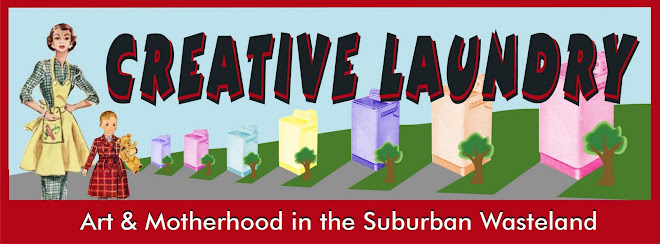
Look! a cow about to give birth. Be thankful for my bad photography, it blurs all the icky parts. I took this picture at a local dairy farm on the weekend. Part of me would have liked to have stayed to see the birth, but then this cow was glaring (yes, I'm sure glaring) and mooing loudly at me as if shouting, "DO SOMETHING!".
From my own birth experience that would mean rubbing lavender oil on her hooves, playing her Enya's soothing melodies, and telling her to imagine her body opening up like a rose. I read that last bit in a book about natural childbirth. Not exactly accurate. If they wanted to keep the rose metaphor, they should have written, "imagine a rose tearing into your body with it's acid dripping jagged glass petals while you scream repeatedly for those pain killing drugs you refused to have in your birth plan you misguided hippy mom to be!". And FYI, I can never listen to Enya again without getting crampy.
My daughter and I were alone in the barn when a farm hand came in and laughed, "She sure is agitated! and taking her time, normally they just lie down and out it comes" At that point my daughter was nudging me to leave, whispering, "this is freaky!"
Her comment reminded me there are less than a week until my kids start summer holidays. Dragging them to all the farms I love to visit during the summer months will be nearly impossible. So I've decided everyday, until school is out, to go and do something they'd hate, that I love.
Day 1 was a nature walk with the sole intention of looking closely at plants. An activity that would bore any person under 40 to tears, and probably a good many over 40 as well.
I'm more than halfway through a botanical illustration course and have acquired a naturalist's scientificky interest in plants. I'm feeling all sorts of possibilities for atonement. Me! plant murderer! I will learn and become a nurturer and protector of plants! But... then I ripped a plant out of the ground to bring home and study in detail... meh, whatever.
I recently read online about artists combining walking with outdoor sketching, nothing new, but slapped with a new label - sketchercising. I thought I should go do some plein air sketching too. While I was packing up my pencils and moleskin sketchbook, I realized... uh-uh, not for me.
A bear and her 2 cubs walked across the road not more than 20' from me recently, and the sightings of bear around here are constantly increasing. I'm not exactly afraid of them. What I can imagine is a scene where I'm sitting in the woods, dead quiet, deep in concentration drawing a plant. I'm so still a bear is right behind me eating berries unaware of my presence. I shift, making noise, the bear startles, and has one of those all too human reactions, swats me in surprise. A swat from a bear could result in a little decapitation, and yes, there is such a thing as a being a "little" decapitated. Uh... so no, I'm drawing house plants. Here's a botanical sketch I did of an orchid last week.






